While incorporating a series of innovative features and significant firsts, the 20.3m scalloper Summer Rose OB 141, built by Parkol Marine Engineering of Whitby for the Star Fishing Company Ltd, is based on well-established and mutually beneficial business associations which played key roles in facilitating the new build, reports David Linkie
The Star Fishing Company is an equal partnership between John McAlister (Oban) Ltd and Seafood Ecosse Ltd, Peterhead. John McAlister’s association with the Peterhead fish and shellfish processors goes back 40 years to when he first started landing scallops to Foster Gault, the now retired MD of Seafood Ecosse, who has since been succeeded by Jim Stephen.
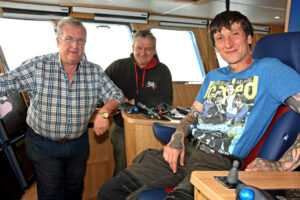
John McAlister with skippers Ian Fletcher and Iain McAlister.
Having used the renowned engineering services provided by the late John Oliver at Whitby for the first time over 20 years ago, John McAlister subsequently commissioned two new 19m automated scallopers, Ròis Mhàiri OB 45 and Star of Jura OB 278, built by Parkol Marine Engineering in 2005 and 2006 respectively. The consistently successful performances of these vessels over more than a decade were a key factor in the decision to build Summer Rose.
The new boat takes her name from the first scalloper John McAlister skippered, a 40ft wooden-hulled vessel built by Tommy Summers at Fraserburgh for Peterhead owners. It was powered by an 80hp Gardner engine. John McAlister, who originally comes from the Isle of Gigha, situated west of the Mull of Kintyre, bought Summer Rose from John McKerral of Campbeltown in 1977 for £10,000.
Building the new Summer Rose was facilitated by the commercial branch of the Royal Bank of Scotland, Inverness, and in particular the support and encouragement manager Lindsay Smith has provided over the past two decades to the owners.
On engine and fishing trials from Whitby, a Sunderland Marine flag flew proudly from the forward mast of Summer Rose. Presented by David Burke to John McAlister at the naming ceremony, this encapsulates the fact that the two companies have worked together since 1971.
The rationale behind the decision to build Summer Rose was to maximise fishing efficiency, crew safety, fuel economy and catch quality.
The presence of two MOB recovery systems (QuikSling and Lalizas) on the aft shelterdeck is indicative of the emphasis skippers Iain McAlister and Ian Fletcher, together with the owners, have given to enhancing every aspect of crew safety on Summer Rose.
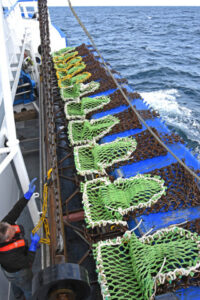
The Killybegs company EK Marine supplied the outer hull tipping doors.
Streamlining the vessel’s appearance was also given considerable thought, as shown by the presence of a curved gantry aft of the wheelhouse roof. This provides a wide surface area on which to mount the usual array of satellite domes and antennae/ whips, and replaces the previous customary ‘Christmas tree’ style aft mast.
Built by Parkol Marine Engineering of Whitby to a new round bilge hull form developed by Ian Paton of SC McAllister & Co Ltd, Summer Rose is designed to fish up to 11 dredges aside, worked in conjunction with outer hull tipping doors and catch hoppers/conveyors.
Achieving a parallel hull length of 11m on an under ticket size vessel (sub-16.49m registered length), at the same time as keeping the towing point forward of the rudder stock to ensure the maximum manoeuvrability deemed essential by scallop skippers when making frequent tight turns around small peaks, ground edges and wrecks, represented a considerable challenge for designer Ian Paton.
Initial indications on trials, when in old-money terms Summer Rose could be said to turn on a sixpence, are that this has been met head-on and delivered in full, albeit not without a huge amount of effort.
In addition to the new hull design, another three features contribute to what in reality is an integrated solution:
■ hydraulically operated horizontal towing arms
■ large-diameter slow-running propeller
■ new design of triple rudder
Positioned atop the shelterdeck aft of the wheelhouse and forward of the rudder stock, the towing arms, fabricated by EK Marine, can be extended 2.5m out from the sides of the hull. Based on a similar principle to a telescopic crane boom, with one heavy steel box section sliding inside another, and controlled from the fishing consoles in the wheelhouse, the extending towing arms offer two major advantages:
■ In terms of safety, they eliminate the need for crewmen to reach out over the side of the vessel when clipping in the Gilson hook, as the hanging block is easily brought to the side.
■ When turning during a tow, the arm on the inside of the turn can be brought in, thereby bringing the fulcrum point closer to the hull to give maximum turning leverage.
Summer Rose is expected to work three- or four-day trips in line with market requirements, sailing with a crew of four or five. Wheelhouse duties will be shared by skippers Iain McAlister and Ian Fletcher, with the latter also sailing as relief skipper to Will Pritchard on Ròis Mhàiri.
Oban Scallop Gear supplied the frames and tooth bars, while the chain bellies came from Deeside Marine, Kirkcudbright.

Starboard quarter view of Summer Rose.
After a couple of shakedown trips off the east coast of England, Summer Rose is expected to follow a seasonal pattern of fishing around Scotland, regularly landing into such ports as Campbeltown, Mallaig, Scrabster and Fraserburgh, in addition to Oban, as well as elsewhere in the UK. The presence of cameras mounted on either side of the Gilson gantry, which constantly monitor the number of dredges in compliance with a Marine Scotland initiative that enables boats to fish in areas where the number of dredges is limited to eight or 10 aside, reflects the owners’ well-proven track record of harvesting traditional inshore scallop grounds for short periods. The success of this contributed to the new build, and also illustrates the owners’ continuing commitment to regulatory compliance and sustainable fishing.
John McAlister said: “A lot of people have put a huge amount of effort into the design and build of Summer Rose, for which we are very grateful. Having previously built two new boats at Whitby, we had no hesitation in returning for a third. Improving on well-proven and successful boats is not an easy task, but initial indications are that this request has been achieved by all those who contributed to an integrated end result.
“Although more challenging situations will no doubt be experienced sooner rather than later, the early signs are very promising, in terms of ease of working, fuel consumption and seakeeping qualities, while the level of build quality speaks for itself.”
The main dimensions of Summer Rose are LOA 20.3m, registered length 16.47m, beam 7.4m, depth moulded 4.6m, draft 5m and GT 141 tonnes.
As they sometimes work in areas where large quantities of tangles are taken and need to be manually cleared from the dredges every haul, the owners steered away from a fullyshelterdecked vessel in order to give easy access to the gear. The other benefit of this decision was, of course, the considerable saving it represented in terms of tonnage licensing.
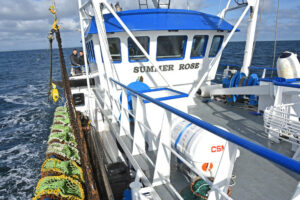
General arrangements on the shelterdeck.
A key feature of Summer Rose, which is insured by Sunderland Marine, is the amount of room and the resulting freedom of movement available on the main deck, on which only the main split trawl winches are positioned. The Gilson winches are located on the steel shelterdeck, while the pulling down winches are mounted on the legs of the lifting gantry amidships.
By offsetting the fishroom hatch to port, the owners have created an obstruction-free walkway from the deck casing to the forecastle, where the catch is sorted. Immediate access is also available at shelterdeck level, where the wheelhouse is slightly offset to starboard to create a walkway along the central part of the open shelterdeck down the portside of the wheelhouse.
Close liaison between owners and designer has ensured that full use has been made of the considerable space available on Summer Rose. This is particularly noticeable in the deck house, the forward part of which is centrally positioned between the side reception hoppers and catch conveyors.
A well-equipped gear workshop is accessed directly from the aft end of the working deck. As well as leading to the main internal passageway in the deck casing, this working area also leads to a walk-in room to port, in which the computers for the wheelhouse electronic equipment, together with the electrical control panel for the deck machinery, are housed.
The spacious messdeck and galley area is arranged across the full width of Summer Rose aft. Bench seating is arranged on three sides of two tables in the starboard messdeck, which is partly screened from the galley. This features the customary range of modern electrical appliances on three sides.
A large shower/WC compartment to port forward of the galley area is accessed from a central area, which also leads to the aft cabin, engineroom and wheelhouse.
Below main deck level, the layout of Summer Rose from forward follows the fairly standard arrangement of forepeak, sonar compartment, fish-hold, engineroom and accommodation.
Down the aft stair, the main accommodation cabin is subdivided to give three twoberth cabins and a single-berth skipper’s cabin. Every opportunity has been taken to maximise locker storage and bench seating for the comfort of the crew.
All internal accommodation areas on Summer Rose are finished to an extremely high standard using a combination of solid oak and matching lightcoloured laminates to give an attractive and homely feel which is already appreciated by the crew. The presence of a compass rose incorporating the vessel’s name in the wood-effect planked floor of the wheelhouse is symbolic of the overall level of finish.
Mitsubishi main and auxiliary power from Padmos
The Netherlands company Padmos achieved a notable first by supplying the four Mitsubishi main and auxiliary power units installed in the engineroom of Summer Rose.
This further strengthens the working relationship that the boatbuilders and owners have developed with the Stellendam company in recent years.
Mitsubishi engines installed on a number of new vessels built by Parkol Marine Engineering of late have been commissioned by Padmos engineers after they crossed the North Sea on the Rotterdam-Hull ferry.
The 23.95m eurocutter Geertruida OB 99, bought from Holland in November 2012 by John McAlister (Oban) Ltd, was fitted out by Padmos in 2000. Dedicated to propulsion duties, the Mitsubishi S6R2-MPTK-F main engine develops 480kW @ 1350rpm and is coupled to a Reintjes WAF 374 7.09:1 reduction gearbox.
As part of Summer Rose’s fully integrated hull and propulsion package, Ian Paton also designed the customised 2300mmdiameter four-blade propeller and matching nozzle fabricated by Parkol Marine Engineering. Fitted with lip seals, the sterngear was machined by Premier Engineering of Scarborough.
This combination results in a maximum propeller speed of 190rpm, and one of around 110rpm when typically towing at three knots with the main engine running at 800rpm.
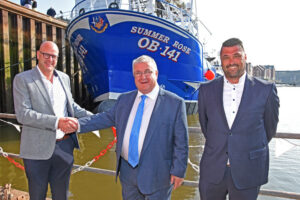
Leon Padmos of Padmos congratulates John McAlister after the naming ceremony of Summer Rose, watched by chief engineer Daniel Vlietland.
The centreline combination gave Summer Rose an average top speed of 9.8 knots on engine trials. Perhaps more importantly for a vessel that will spend more than 80% of its time at sea comfortably towing 11-aside dredges into the tide at 2.8/3 knots in 33 fathoms of water, on fishing trials outside 12 miles east of Whitby, Summer Rose was using 38 to 40 litres of fuel an hour @ 780/800rpm. Skippers Iain McAlister and Ian Fletcher were particularly impressed by Summer Rose’s towing capabilities, in addition to being more than happy with the initial indication of an economical rate of fuel consumption, which is significantly lower than that of Ròis Mhàiri and Star of Jura.
A Mitsubishi S6B3 variablespeed hydraulic engine drives the scalloper’s main loadsensing hydraulic system in conjunction with a Technodrive splitter box and two Kawasaki pumps. Installation of the vessel’s hydraulic system was completed in-house by Parkol Marine Engineering with stainless steel being used throughout.
Electrical power on Summer Rose comes from two Mitsubishi 6D16-T auxiliary engines, each driving 125kVa Stamford 415/3/50 generators.
Three Victron 100-amp chargers serve the three sets of batteries in the engineroom. A similar Victron charger is situated in the wheelhouse to serve the lighting batteries, in addition to a 50 amp GNDSS charger.
Pearson Electrical of Hull was subcontracted by Parkol Marine Engineering to undertake the electrical installation work on Summer Rose alongside the boatyard’s own electricians.
Cooling for the four engines and the hydraulics is provided through NRF box coolers arranged across the forward end of the engineroom.
The engineroom on Summer Rose is particularly spacious, with an extremely well thought-out arrangement ensuring maximum access for all levels of service in years to come.
A total of 24,000 litres of fuel are carried in two wing tanks in the engineroom and a double bottom tank under the fishroom floor. 4,500 litres of freshwater are housed in the bulbous bow.
Advanced wheelhouse electronics from Electrotech Marine
Summer Rose is equipped with an array of hi-tech electronics supplied, installed and commissioned by David Simcox of Electrotech Marine, Oban.
With vessel positioning and ground discrimination essential for effective scalloping, not surprisingly Summer Rose features state-of-theart underwater acoustic sounding equipment and seabed plotting systems that will give skippers Iain McAlister and Ian Fletcher optimum levels of information of the scalloper’s position relative to seabed contours.
Sixteen AG-Neovo monitors, including 12 19in screens, are flush-mounted in the wellarranged wheelhouse. Two tiers of monitors are housed in the streamlined main forward console, in front of a central NorSap skipper’s chair flanked by two island consoles on which the master fishing console, engine/steering, autopilot and sonar control units are mounted. Duplicate sets of engine/steering consoles and fishing consoles are positioned on shallow wing consoles.
An office area, in which are housed two 17in monitors dedicated to vessel administration and the internet, is located in the aft starboard corner of the wheelhouse. Tea/coffee-making facilities, together with a compact sink and fridge, are located to port. The engine exhaust systems are routed up through a central housing, ensuring that the skipper has full line of vision to the towing arms at all times.
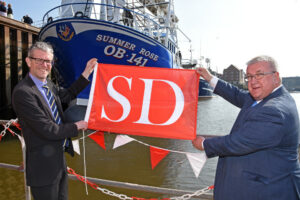
David Burke presents a Sunderland Marine flag to John McAlister at the scalloper’s naming ceremony.
Light-coloured oak laminates and wood-effect flooring, which includes a Summer Rose compass rose, are used in the spacious wheelhouse, in which SolarGlide screens are fitted to every window.
A Furuno CSH 250 searchlight sonar (60kHz) provides forward vision. A WASSP F3 160kHz Multibeam system is interfaced to a Furuno TimeZero plotter. Vertical bottom sounding is handled by a Simrad S5100 unit with Chirp or fixed frequency modes of 42kHz -65kHz and 130kHz -210kHz.
The 2/3D outputs from two Olex plotting systems are both displayed on twin screens. The main radar is a Furuno FAR211BB model, backed up by a halo broadband radar facility provided by a Simrad EVO2 multifunction BB unit that also provides further bottom sounding and plotting options.
A Furuno SC-70 satellite compass further enhances the performance of the Simrad AP70 autopilot system, which includes three joystick controls and two Simrad rudder angle indicators.
Further evidence of the high level of electronic equipment installed on Summer Rose is provided by the presence of a Furuno BR500 Bridge Navigation Watch Alarm System (BNWAS) which is interfaced to a motion detector mounted in the overhead console to constantly monitor the wheelhouse.
Eight of the X-19 screen displays are switchable via an 8 x 8 HDMI matrix, while a further four are dedicated to CCTV and Simrad EVO2 multifunction.
All the flat-screen displays, computers and matrix were supplied by Four UPS Units.
Communication equipment includes a Sailor 6310 MF/HF GMDSS 150W radio telephone, two Sailor 6210 VHFs and a Jotron Emergency GMDSS Handheld VHF. Woodsons of Aberdeen supplied a V-Sat communications system.
A wide-coverage CCTV system consisting of nine four-megapixel HD cameras and a 16-way HD VR was installed by Electrotech Marine. An interesting additional item is an HD through-hull propeller camera with the facility to be withdrawn into the vessel for lens cleaning.
More detail and images via Fishing News








